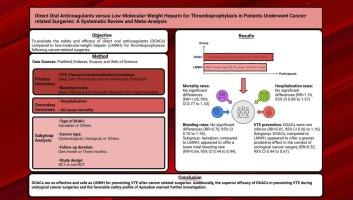Direct oral anticoagulants versus low-molecular-weight heparin for thromboprophylaxis in cancer-related surgeries: A meta-analysis of efficacy and safety outcomes
IF 1.8
Q3 CARDIAC & CARDIOVASCULAR SYSTEMS
American heart journal plus : cardiology research and practice
Pub Date : 2025-09-11
DOI:10.1016/j.ahjo.2025.100607
引用次数: 0
Abstract
Background
Post-operative venous thromboembolism (VTE) remains a concern following cancer-related surgeries. This systematic review and meta-analysis aimed to evaluate the safety and efficacy of direct oral anticoagulants (DOACs) compared to low molecular weight heparin (LMWH) for thromboprophylaxis after cancer-related surgeries.
Methods
We systematically searched databases for studies comparing DOACs to LMWH for post-operative thromboprophylaxis in patients undergoing cancer-related surgeries. Primary outcomes were VTE incidence and bleeding events. Secondary outcomes included all-cause mortality and hospitalization rates. Subgroup analyses examined DOAC type, cancer type, and follow-up duration. A random-effects model calculated pooled risk ratios (RRs) with 95 % confidence intervals (CIs).
Results
Analysis included 16 studies with 6400 participants in the DOAC group (mean age 62.05 years, 28.15 % male) and 5801 participants in the LMWH group (mean age 60.78 years, 34.65 % male). DOACs were non-inferior to LMWH for VTE prevention (RR = 0.81, 95 % CI 0.56 to 1.16) with no significant difference in bleeding rates (RR = 0.70, 95 % CI 0.70 to 1.18). Mortality and hospitalization rates were similar between groups. Subgroup analyses suggested possible VTE reduction with DOACs in urological cancer surgeries (RR = 0.52, 95 % CI 0.44 to 0.61) and lower bleeding trends with Apixaban (RR = 0.64, 95 % CI 0.44 to 0.94).
Conclusions
DOACs appear non-inferior to LMWH for post-operative thromboprophylaxis in patients undergoing cancer-related surgeries, with comparable safety. The superior VTE prevention in urological cancer surgeries and Apixaban's favorable safety profile warrant further investigation. Moreover, additional research is necessary to clarify the roles of specific DOACs and optimal prophylaxis strategies across various cancer types and surgical procedures.

直接口服抗凝剂与低分子肝素在癌症相关手术中预防血栓:疗效和安全性的荟萃分析
背景:在癌症相关手术后,术后静脉血栓栓塞(VTE)仍然是一个值得关注的问题。本系统综述和荟萃分析旨在评价直接口服抗凝剂(DOACs)与低分子肝素(LMWH)在癌症相关手术后血栓预防中的安全性和有效性。方法:我们系统地检索数据库,比较DOACs与低分子肝素在癌症相关手术患者术后血栓预防中的作用。主要结局是静脉血栓栓塞发生率和出血事件。次要结局包括全因死亡率和住院率。亚组分析检查DOAC类型、癌症类型和随访时间。随机效应模型以95%的置信区间(ci)计算合并风险比(rr)。结果纳入16项研究,DOAC组6400例(平均年龄62.05岁,男性28.15%),低分子肝素组5801例(平均年龄60.78岁,男性34.65%)。DOACs在静脉血栓栓塞预防方面不低于低分子肝素(RR = 0.81, 95% CI 0.56 ~ 1.16),出血率无显著差异(RR = 0.70, 95% CI 0.70 ~ 1.18)。两组之间的死亡率和住院率相似。亚组分析表明,在泌尿外科癌症手术中,DOACs可能降低静脉血栓栓塞(RR = 0.52, 95% CI 0.44至0.61),阿哌沙班可能降低出血趋势(RR = 0.64, 95% CI 0.44至0.94)。结论在接受癌症相关手术的患者中,doacs在术后血栓预防方面并不逊于低分子肝素,且具有相当的安全性。泌尿外科肿瘤手术中静脉血栓栓塞的预防优势和阿哌沙班良好的安全性值得进一步研究。此外,需要进一步的研究来阐明特定doac的作用以及各种癌症类型和外科手术的最佳预防策略。
本文章由计算机程序翻译,如有差异,请以英文原文为准。
求助全文
约1分钟内获得全文
求助全文
来源期刊

American heart journal plus : cardiology research and practice
Cardiology and Cardiovascular Medicine
CiteScore
1.60
自引率
0.00%
发文量
0
审稿时长
59 days
 求助内容:
求助内容: 应助结果提醒方式:
应助结果提醒方式:


